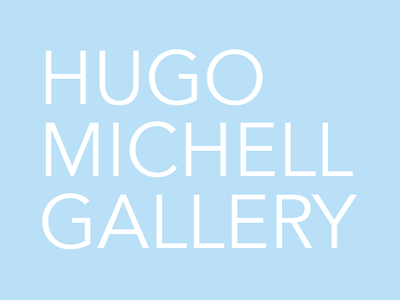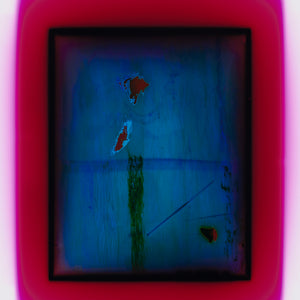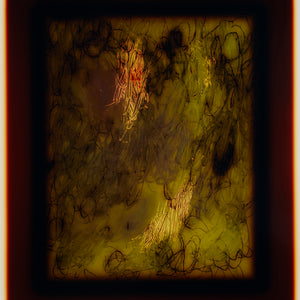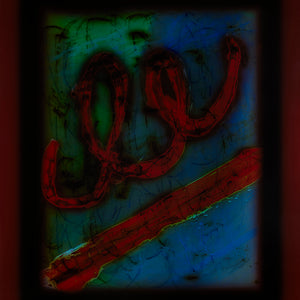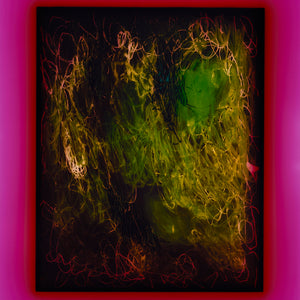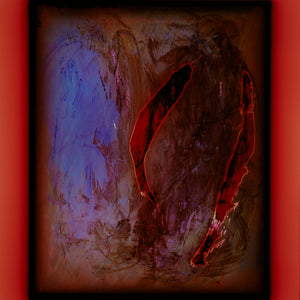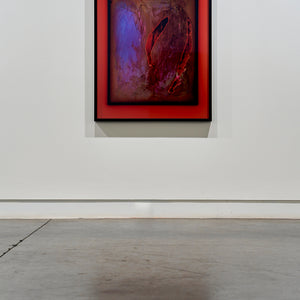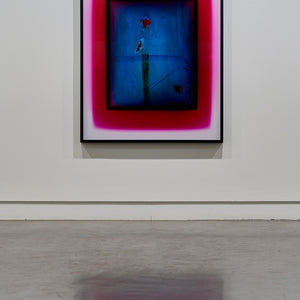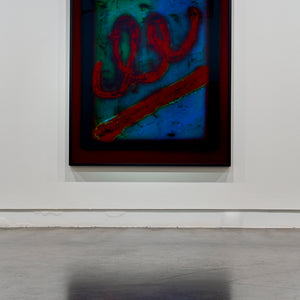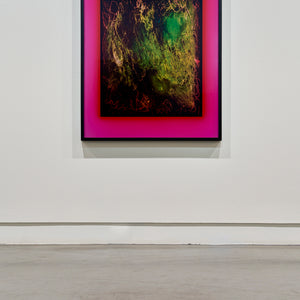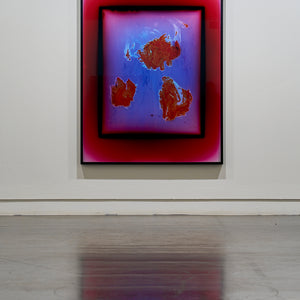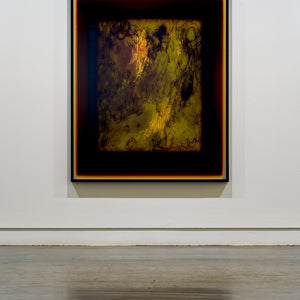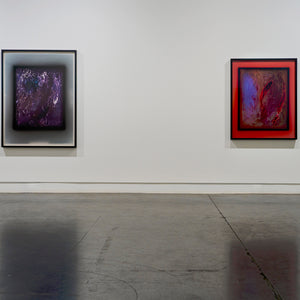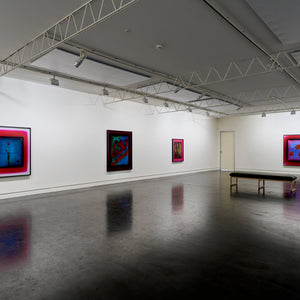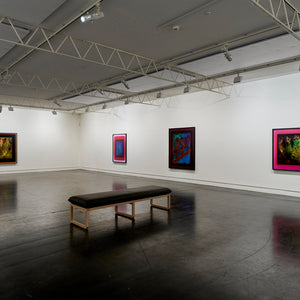DIFFUSION
7 February to 9 March 2024
Developing the darkroom
written by Justine Varga
Everything that you see within my photographs tells you something about the process of their becoming. To the initiated, all these things can be read, if they choose to engage in that reading process. Nothing in the work is simply decorative, everything is there for a specific reason, as evidence of an action. This most recent series of photographs, for example, has evolved to include projected colour at their margins. This is a recent departure for my work.
In general, when looking at photographs, we are often asked to not look at, or pay attention to, the border at all. We are asked to concentrate on the image at the centre, as solely constituting the photograph. I wanted to complicate that experience of looking by creating a colour at the edge. Basically, I thought the binary choice between a black border or a white one just wasn’t enough of a decision to make. I wanted to create an agency over the entire photographic object. Even for me, as the maker of this photograph, I was surprised at the way the red that we find within the margin--indeed, that is the margin--would give rise to the way we experience the imprint of the negative that it seemingly contains. By doing this, I wanted to challenge the hierarchy between the edge and the centre, to bring attention to the way that the centre generates the edge, but also the way in which the edge informs the centre. In other words, the two are always a complex entwinement.
Over a number of years, I have been working in this manner, making photographs by way of a haptic rendering of the negative. So, my photographs are durational entities; the exposure of the negative occurs over days, weeks, months, and sometimes years. The negative that was printed from to create the work we are looking at now was exposed over a number of months here in Oxford, where I am currently living. I combined painting and drawing as I marked the sheet of negative film, allowing for the presence of the touch of the hand within the final work. Here, in the surface of the print, you can see the fingerprints and other traces of myself as I have handled the negative. Furthermore, through the use of an internegative process, negative and positive states are made to inhabit this work simultaneously.
Rather than the primacy afforded to the moment of inscription on the negative or other means of photographic image capture, I pay specific attention to the final photographic object. In other words, I put a lot of creative effort into the print that is made within the darkroom, and all the specific operations that occur within that space of transformation. The exposure and inscription of the negative is something that is integral to my photography, but, in truth, it is no longer my primary concern in the making of my work. At the moment, I am more interested in what happens in the darkroom when I am printing from a negative.
When thinking about photography, people are often thinking about the moment when the shutter is pressed, when the moment of initial exposure happens, as if that constitutes the photograph. However, my photography is comprised of and from being, and that is something that is much more durational in nature. So, yes, I am working onto the negative, and drawing onto it, sometimes rubbing my saliva into it: it’s a very bodily sort of thing. But that said, this is not really where my thinking is now, not even at the moment when I am exposing the negatives. It is just one step in an extended process of production.
When I am inscribing, I am exposing; by this means, the exposure becomes the inscription, and the inscription is exposed. In the past, I have said this: as soon as the negative is exposed to light it is ruined, and, indeed, it is within the acceptance of that fact that the work can begin. Yes, the negative can be likened to a blank sheet of paper. But we are not talking about symbolic gestures, there is always already a mark. In photography we are invested in the index: an inscription of the world by photographic means. The negative registers the first traces of that inscription. Then, this exposed negative, in all its imperfection, can be breathed through with light when printed from in the darkroom. By this means that world is re-inscribed again and again, in all its complexity, as a photographic print. Even if that print, in the end, is yet another ruin. It is here, when all is seemingly lost, that we can finally get to where photography is, perhaps.
The light from the enlarger that gives rise to a photographic print is meant to be contained within a strictly controlled rectangle. So, having a spread of light, as colour, visibly spilling beyond that frame is a transgression. But this is manifold within my work. As we have discussed, the very way that the negative is inscribed and exposed is a transgression. The manner in which I practice photography attempts to interrogate its form and function. Yes, that interrogation takes place within the various architectures of photography, but also, by extension, within its social and political economies. Photography is, after all, an embodiment of modernity. To contest or disrupt photography’s representational conventions is therefore to contest and disrupt modernity itself. That’s what I am aiming to do. Even though there is a graphicness to the work, obviously, it is not about an image alone. What I am concerned with is the entire photographic object, with photography in its entirety. When an audience comes to stand in front of one of my prints in a gallery, they are invited to have an encounter with photography in this widest sense.
This is an edited extract from an interview conducted by Cecilia Grönberg & Jonas (J) Magnusson, Oxford, April 10, 2023. The full interview, along with a portfolio, and several of Varga’s essays, will be available in the forthcoming issue of the Swedish journal OEI: Photography on Edge. https://www.oei.nu
Preview requests to mail@hugomichellgallery.com
